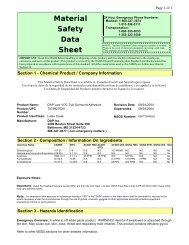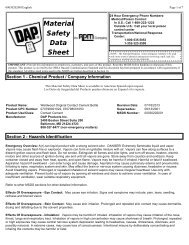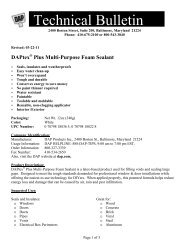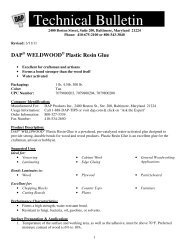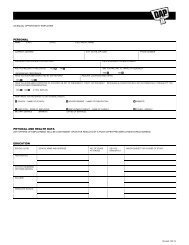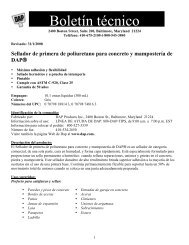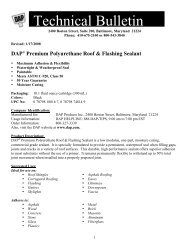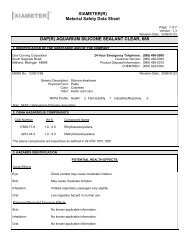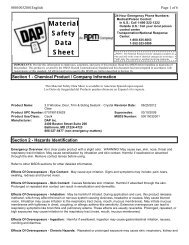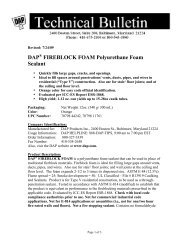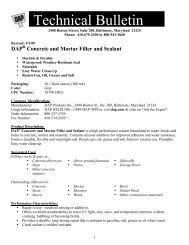XIAMETER(R) Material Safety Data Sheet DAP(R)SILICONE PLUS ...
XIAMETER(R) Material Safety Data Sheet DAP(R)SILICONE PLUS ...
XIAMETER(R) Material Safety Data Sheet DAP(R)SILICONE PLUS ...
Create successful ePaper yourself
Turn your PDF publications into a flip-book with our unique Google optimized e-Paper software.
<strong>XIAMETER</strong>(R)<br />
<strong>Material</strong> <strong>Safety</strong> <strong>Data</strong> <strong>Sheet</strong><br />
Page: 2 of 9<br />
Version: 1.0<br />
Revision Date: 2007/11/14<br />
<strong>DAP</strong>(R)<strong>SILICONE</strong> <strong>PLUS</strong> PREMIUM <strong>SILICONE</strong> RUBBER SEALANT KITCHEN &<br />
BATH ALMON<br />
The above listed potential effects of overexposure are based on actual data, results of studies performed upon similar compositions,<br />
component data and/or expert review of the product. Please refer to Section 11 for the detailed toxicology information.<br />
3. COMPOSITION/INFORMATION ON INGREDIENTS<br />
CAS Number Wt % Component Name<br />
64742-46-7 3.0 - 7.0 Hydrotreated middle petroleum distillates<br />
22984-54-9 1.0 - 5.0 Methyl tri(ethylmethylketoxime) silane<br />
96-29-7 1.0 - 5.0 Methylethylketoxime<br />
The above components are hazardous as defined in 29 CFR 1910.1200.<br />
4. FIRST AID MEASURES<br />
Eye:<br />
Skin:<br />
Inhalation:<br />
Oral:<br />
Notes to Physician:<br />
Immediately flush with water for 15 minutes.<br />
Remove from skin and immediately flush with water for 15 minutes. Get medical attention if<br />
irritation or ill effects develop or persist.<br />
Remove to fresh air. Get medical attention if ill effects persist.<br />
Get medical attention.<br />
Treat according to person's condition and specifics of exposure.<br />
5. FIRE FIGHTING MEASURES<br />
Flash Point:<br />
Not applicable.<br />
Autoignition Temperature: Not determined.<br />
Flammability Limits in Air:<br />
Extinguishing Media:<br />
Fire Fighting Measures:<br />
Unusual Fire Hazards:<br />
Not determined.<br />
On large fires use dry chemical, foam or water spray. On small fires use carbon dioxide<br />
(CO2), dry chemical or water spray. Water can be used to cool fire exposed containers.<br />
Self-contained breathing apparatus and protective clothing should be worn in fighting large<br />
fires involving chemicals. Determine the need to evacuate or isolate the area according to<br />
your local emergency plan. Use water spray to keep fire exposed containers cool.<br />
None.<br />
6. ACCIDENTAL RELEASE MEASURES


